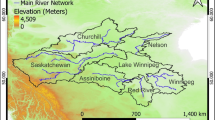Abstract
Vegetation classification is an important topic in plant ecology and many quantitative techniques for classification have been developed in the field. The artificial neural network is a comparatively new tool for data analysis. The self-organizing feature map (SOFM) is powerful tool for clustering analysis. SOFM has been applied to many research fields and it was applied to the classification of plant communities in the Pangquangou Nature Reserve in the present work. Pangquangou Nature Reserve, located at 37°20′–38°20′ N, 110°18′–111°18′ E, is a part of the Luliang Mountain range. Eighty-nine samples (quadrats) of 10m × 10m for forest, 4m × 4 m for shrubland and 1m × 1m for grassland along an elevation gradient, were set up and species data was recorded in each sample. After discussion of the mathematical algorism, clustering technique and the procedure of SOFM, the classification was carried out by using NNTool box in MATLAB (6.5). As a result, the 89 samples were clustered into 13 groups representing 13 types of plant communities. The characteristics of each community were described. The result of SOFM classification was identical to the result of fuzzy c-mean clustering and consistent with the distribution patterns of vegetation in the study area and shows significant ecological meanings. This suggests that SOFM may clearly describe the ecological relationships between plant communities and it is a very effective quantitative technique in plant ecology research.
Similar content being viewed by others
References
Chen T G, Zhang J T (2000). A study of plant community diversity in Shenweigou of the Pengquangou Reserves, Shanxi. Acta Botanica Boreali-Occidentalia Sinica, 20(4): 638–646 (in Chinese)
Cheng Z H, Zhang J T, Wu B H, Niu L Q (2006). Relationships between tourism development and vegetation environment in Luya mountain nature reserve: vegetation landscape types and ordination. Acta Ecologica Sinica, 26(6): 1940–1946 (in Chinese)
Feisi Center for Scientific Products (2004). MATLAB 6.5 Designe and analysis of artificial neural network. Beijing: Electronic Industry Press (in Chinese)
Li B, Zhang J T (2003). Analysis of relationships between vegetation and climate variables in Loess Plateau. Acta Botanica Sinica, 23(1): 82–89 (in Chinese)
Li S C and Zheng D (2003). Progress of the application of artificial neural network to earth science. Progress of Earth Science, 18(1): 69–70 (in Chinese)
Schreer J F, Hines R J O, Kovacs KM (1998). Classification of dive profiles: A comparison of statistical clustering techniques and unsupervised artificial neural networks. Journal of Agricultural Biological and Environmental Statistics, 3(4): 383–404
Tran L T, Knight C G, O’Neill R V (2003). Self-organizing maps for integrated environmental assessment of the Mid-Atlantic region. Environmental Management, 31(6): 822–835
Wu P Q and Huang M S (2005). The application of SOM on the classification of Fujian cities’ functions. Economic Geography, 25(1): 68–70 (in Chinese)
Yang H X, Lu Z Y (1981). Methods of quantitative classification in plant ecology. Beijing: Science Press (in Chinese)
Yu S X (1995). Introduction to mathematical ecology. Beijing: Scientific Literature Press (in Chinese)
Yuan Z R (2000). The artificial neural network and its application. Beijing: Qinghua University Press (in Chinese)
Zhang F, Zhang J T (2000). Progress of quantitative classification and ordination research in China. Journal of Shanxi University (Nat Sci Ed), 23(3): 278–282 (in Chinese)
Zhang J T (1994a). A comparison of fuzzy c-mean clustering and TWINSPAN. Journal of Wuhan Botanical Research, 12(1): 11–17 (in Chinese)
Zhang J T (1994b). Canonical indicator species analysis, a new extrinsic classification technique. Acta Phytoecologica Sinica, 18(4): 331–337 (in Chinese)
Zhang J T (2004a). Fuzzy mathematic classification and ordination of plant communities in Pangquangou Natural Reserve. Journal of Beijing Normal University (Natural Science), 40(2): 249–254 (in Chinese)
Zhang J T (2004b). Quantitative ecology. Beijing: Science Press (in Chinese)
Zhang J T (2005). Canonical principal component analysis of forest communities in Lishan Natural Reserve, Shanxi Province, North China. Journal of Biomathematics, 20(2): 213–218 (in Chinese)
Zhang J T, Chen T G (2004). Variation of plant communities along an elevation gradient in the Pengquangou Reserves, North China. Community Ecology, 5(2): 227–233
Author information
Authors and Affiliations
Corresponding author
Additional information
__________
Translated from Acta Ecologica Sinica, 2007, 27(3): 1005–1010 [译自: 生态学报]
Rights and permissions
About this article
Cite this article
Zhang, J., Yang, H. Application of self-organizing neural networks to classification of plant communities in Pangquangou Nature Reserve, North China. Front. Biol. China 3, 512–517 (2008). https://doi.org/10.1007/s11515-008-0061-7
Published:
Issue Date:
DOI: https://doi.org/10.1007/s11515-008-0061-7




